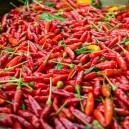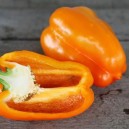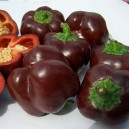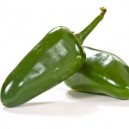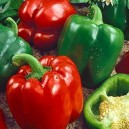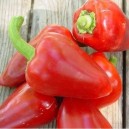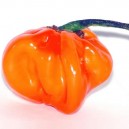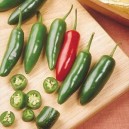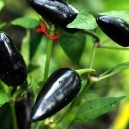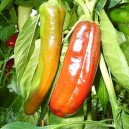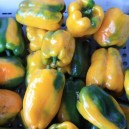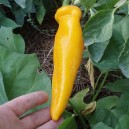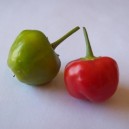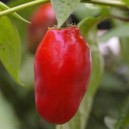
Welcome, Log in
Product Categories
-
Heirloom & OP Seed
- Cool Weather Crops
- Warm Weather Crops
- Beans
- Beetroot
- Brassicas
- Carrots
- Chard
- Corn/Maize
- Cucumbers
- Eggplant (Aubergine)
- Leeks
- Lettuce
- Melons
- Okra
- Onions
- Parsnips
- Peas
- Peppers & Chillies
- Radish
- Spinach
- Squash & Pumpkins
- Tomatoes
- Turnips
- Unusual / Exotic
- Herbs & Spices
- Fruits & Berries
- Value Packs
- View All Seed
- Gift Vouchers
Peppers & ChilliesThere are 18 products.
Please scroll down or click here to view the product list
GROWING INSTRUCTIONS FOR PEPPERS & CHILLIES
Binomial Name: Capsicum
Varieties: Cayenne, Baloon, Hungarian Round, Wax, Ricoto / Manzano, Sweet Bell, Georgia Flame, Black Hungarian, Corno di Toro Giallo, Corno di Toro Rosso, Golden Marconi, Italian Pepperoncini, Purple Beauty, Red Cheese, Anaheim, Pasilla Bajio, Serrano Tampequino, California Wonder, Emerald Giant, Quadrato D'Asti, Red Marconi, Tam Jalapeno, Melrose, Ozark Giant
Start: Seeds or seedlings
Germination: 7 to 25 days, 20°C to 35°C
Seed Life (viability): 3-4 years
Soil: Well drained
Sunlight: Full sun
Sow Seeds: 45 - 60 cm apart
Thin to: 45 - 60 cm apart
Ave. Days to Harvest: 65 to 100
Good Companions: Basil, Carrots, Chives, Garlic, Leeks, Marjoram, Onion, Oregano, Tomatoes, Yarrow
Bad Companions: Fennel, Kohlrabi
Sowing: Peppers can be started indoors about 8 weeks before the last frost is expected. Sow the seed 1/2cm deep in a well-drained starting medium. Seeds require a warm environment to germinate; your growing medium should be between 20 - 35 degrees C with 30C being the ideal. Using a heat mat (available at home and garden stores, hardware stores and even pet shops) can help to ensure ideal conditions. Additionally, young starts will fare much better with additional light. Place in a window or sunny location that receives lots of sun exposure. Consider supplementing with artificial lighting if possible.
Planting: Set plants out 2 to 3 weeks after the last frost when the soil has warmed and the weather has settled. Peppers can be temperamental when it comes to setting fruit if temperatures are too hot or too cool. Nighttime temperatures below 15C or above 23C can reduce fruit set.
Tip: Wait until soil temperatures exceed 10 degrees C at all times before placing into the ground. Pepper plants can be fairly close to one another, so that there is slight contact between plants.
Growing: Peppers need a steady supply of water for best performance but be careful not to overwater. A well drained soil will prevent waterlogging. If fertilizing, be careful not to overdo it on nitrogen as this will give you nice lush and leafy plants but will deter fruit growth. Organic fertilizers and soil should be rich in phosphorus, potassium and calcium.
Mulching with black plastic or similar material is a good way to maintain heat and soil moisture. Additionally, floating row covers over your beds can help to protect against cold early in the growing season. Use caution with row covers not to overheat plants and cause them to drop their blossoms.
Tip: Stake tall varieties for earlier and heavier harvest.
Harvesting: You can pick bell type peppers, when they are smaller, in the beginning of summer. They may be taken when they are the size of a golf ball and frequent picking will encourage near-continuous fruit production. Immature bell peppers are soft and pliable with thin pale walls.
Otherwise, take fully mature bell peppers when they are 10 to 12cm long and have full, well-formed lobes. The older the fruit is, the thicker the skin will be.
Tip: Allow peppers to ripen to their final color later in the season to get fruit of different colors. Ripe peppers may be yellow, red, orange or purple, depending on the variety. You can continue to harvest peppers until the first frost.
-
R 25.00Add to cart More Details
Available -
R 25.00Add to cart More Details
Available -
R 25.00Out of Stock More Details
Coming Soon -
R 25.00Add to cart More Details
Available -
R 25.00Out of Stock More Details
Coming Soon -
R 25.00Out of Stock More Details
Coming Soon -
R 25.00Add to cart More Details
Available -
R 25.00Add to cart More Details
Available -
R 25.00Add to cart More Details
Available -
R 25.00Add to cart More Details
Available -
R 25.00Add to cart More Details
Available -
R 25.00Out of Stock More Details
Coming Soon -
R 25.00Add to cart More Details
Available -
R 25.00Out of Stock More Details
Coming Soon -
R 25.00Add to cart More Details
Available -
R 25.00Out of Stock More Details
Coming Soon -
R 25.00Out of Stock More Details
Coming Soon -
R 25.00Out of Stock More Details
Coming Soon
